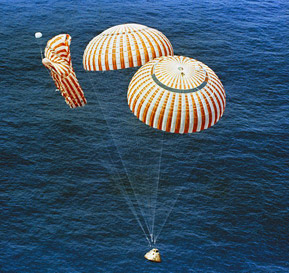Lesson: Design a Parachute
(Lesson courtesy teachengineering and Center for Engineering Educational Outreach, Tufts University). Grade Level: 7 (6-8). Time Required: 60 minutes (30 minutes for construction, 30 minutes for testing and classroom discussion/journal writing). Lesson Pdf
 Overview
Overview
After discussing what a parachute is and how it works, students create a parachute using materials they think will work best. They test their designs, followed by a class discussion and possible journal writing to highlight which paper material worked best.
Learning Objectives
Students will learn:
- Techniques for designing a parachute that falls slowly.
- How to determine which type of material works best by testing different options.
- How air resistance plays a role in flying.
Educational Standards
Massachusetts Science. Grades 6 – 8, 2001
- 2.5 Explain how such design features as size, shape, weight, function, and cost limitations would affect the construction of a given prototype.
- 2.4 Identify appropriate materials, tools, and machines needed to construct a prototype of a given engineering design.
- 2.3 Describe and explain the purpose of a given prototype.
- 1.1 Given a design task, identify appropriate materials (e.g., wood, paper, plastic, aggregates, ceramics, metals, solvents, adhesives) based on specific properties and characteristics (e.g., weight, strength, hardness, and flexibility).
*See teachengineering for other state standards
Engineering Connection
Aerodynamics and fluid flow concepts are used by engineers to design planes, parachutes and ships. Accounting for drag is an important aspect of these designs – engineers redesign the shape and materials used to get better results.
Materials
- Tissue paper
- Napkins
- Construction paper
- Newspaper
- Paper towels
- String
- Tape
- Weights (i.e. washers)
Background
A parachute is an umbrella-shaped device of light fabric used especially for making a safe jump from an aircraft. Due to the resistance of the air, a drag force acts on a falling body (parachute) to slow down its motion. Without air resistance, or drag, objects would continue to increase speed until the object hit the ground. The larger the object, the greater its air resistance. Parachutes use a large canopy to increase air resistance. This gives a slow fall and a soft landing.
Resources
NASA: Forces on a Falling Object
History of the Parachute (About.com)
Procedure
Introduction/Motivation
What is the purpose of a parachute? What is the role of a parachute in skydiving? Imagine you are jumping out of a plane 10,000 feet in the air. What type of material would you want your parachute to be made out of and what size would you want it to be? The design of a parachute is extremely important, especially in an extreme sport like skydiving because someone’s life is dependent on the parachute functioning properly. Engineers must test the materials and design of a parachute to ensure that it will open properly and be strong enough to withstand the air resistance needed to slow the skydiver down enough to a safe landing speed.
For the teacher:
- Buy or gather available materials
- Discuss with the class what a parachute is and how it works.
- Have each team brainstorm characteristics of a good parachute, document their thoughts and sketch their design before construction begins.
- To test the parachutes, have the students go outside and drop it from a specific height to see if it flies slowly and lands gently.
Parachute Construction directions for students:
- Cut a circle from the paper chosen (or test another). Make a hole in the center of the shape.
- Cut six pieces of equal-length string and tape them at equal distances around the edge of the shape.
- Tape the other ends of the string to the weight.
Assessment
Investigating Questions — have the students discuss as a class or in a journal writing.
- What type of paper is the best material to make a parachute? Why?
- What materials did not work well? Why?
- What changes could you make to improve your design?
Extensions
- Using the paper material that worked the best, do the same activity testing the size of the parachute.
- Have students test circles with different radii to find the optimal size.
- Try parachutes with and without holes in the top and different sized holes.
- Make parachutes out of different materials: plastics, cotton, nylon.
- Hold a competition to find a design that can land a toy vehicle most gently.
Owner: Center for Engineering Educational Outreach, Tufts University
Copyright: 2005 by Worcester Polytechnic Institute.
Filed under: Grades 6-8, Lesson Plans








